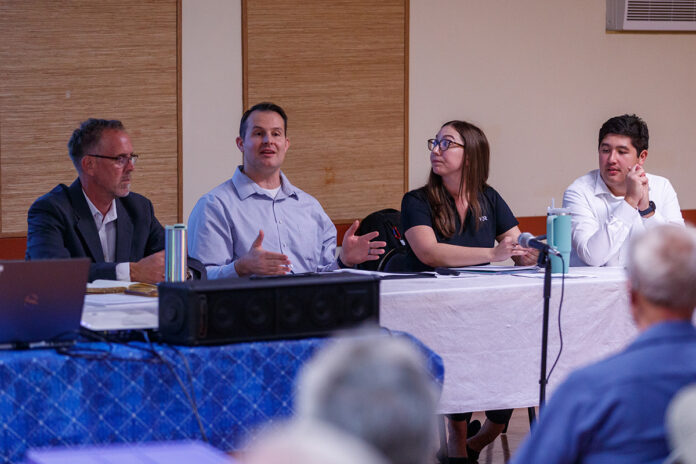The Verde Village Community Connection held a workshop to discuss a sewer feasibility study on Tuesday, Oct. 10.
VVCC received a $200,000 grant through the American Rescue Plan Act in 2022 to fund the study, which was initiated by the previous board, then known as the Verde Village Property Owners Association. The study is an active measure to determine potential options if the state gives notice that the community should move away from septic systems to protect groundwater and the Verde River.
The Verde Village community is made up of around 4,500 housing units with around 11,400 residents.
The study is being led by Mark Holmes, a Nature Conservancy contractor. He said that the Verde Villages are not currently in violation of the Clean Water Act of 1972, but that they will be and that it is a question of when, not if.
Holmes said that a similar situation had occurred in Chino Meadows, a community built in the 1970s with septic systems that had similar age, size and density as the Verde Villages later annexed into the town of Chino Valley. Water sampling found the community to be in violation, but before the city could be cited, residents voted to put in a sewer system to resolve the issue.
The Verde Village has shallow groundwater very close to the Verde River. No recent testing or sampling has occurred, but the Arizona Department of Water Resources routinely tests wells each year. Holmes said that the Environmental Protection Agency is concerned about per- and polyfluoroalkyl substances, which are widely used, long-lasting chemicals that break down very slowly.
Holmes was accompanied by representatives from HDR Engineering who discussed the study results, including three potential alternatives of collection systems, treatment systems and beneficial reuses.
The options for collection systems would be to have sewer lines go to Cottonwood’s wastewater facility, have sewer lines go to the Yavapai-Apache Nation’s facility or to build a separate plant for the Verde Villages.
If partnering with the city of Cottonwood, five lift stations would need to be built to transport sewage four miles to the wastewater treatment plant. If partnering with the YAN, the flow distance would be closer to nine miles and six lift stations would be required. If building a new water reclamation facility in the Verde Villages were to be selected, a central location of about five acres would need to be chosen and three lift stations built.
For treatment system alternatives, the Verde Villages could either propose an expansion of Cottonwood’s wastewater treatment plant, which is currently at capacity, or the YAN’s treatment plant. If building a new Verde Villages water reclamation facility is selected, HDR recommended a sequencing bioreactor facility that would be modular and flexible. This would occupy three to five acres of land; the proposed site is currently on state land.
For beneficial reuse alternatives, there are a limited number of reuse customers available in the area, such as the Cemex Camp Verde plant, the YAN rock quarry, wineries and nurseries. Factors to consider with reuse include the requirements for consistent demand throughout the year plus an overlap of reuse customers with existing utilities in the region.
If the Verde Villages were to decide to give Cottonwood or the YAN their wastewater to reuse, those entities would retain ownership of the effluent. If the Verde Villages retain ownership through its own facility, then the wastewater could be used to create an alternate or supplemental water source for the duck pond, construct a wetland or riparian preserve or create an aquifer recharge well.
If the duck pond route were to be chosen, it would reduce diversion of water from the Verde River to the pond as well as reduce the cost of purchasing water from the river. The water would also remain a community asset. This option would require permits and the quantity of water would be limited by evaporation rate.
If creating a wildlife preserve were to be chosen, the water could be returned to the river while creating an enjoyable outdoor space for both residents and wildlife.
If an aquifer recharge well were to be created, this would secure the Verde Villages a long-term supply of water, provide a renewable source of water and increase base flows back to the Verde River. This would also require permits.
The engineers’ opinion of probable construction capital costs in 2022 dollars for these options were:
- Partnership with city of Cottonwood: $220 million
- Partnership with YAN: $211 million
- Creation of Verde Villages facility: $193 million
Holmes said that it would be cheaper to build something now rather than later, due to the cost of projects increasing by 5% to 6% every year. He also said that there is also more money in grants right now than ever before. Potential funding opportunities can be found through the EPA and USDA as well as public-private partnerships.
The next steps of the study will include gathering feedback over the next two weeks, followed by a draft feasibility report that will be sent to VVCC by Friday, Nov. 10. After a three-week review and comment period for VVCC, a final feasibility report will be sent to VVCC by Wednesday, Dec. 20.



